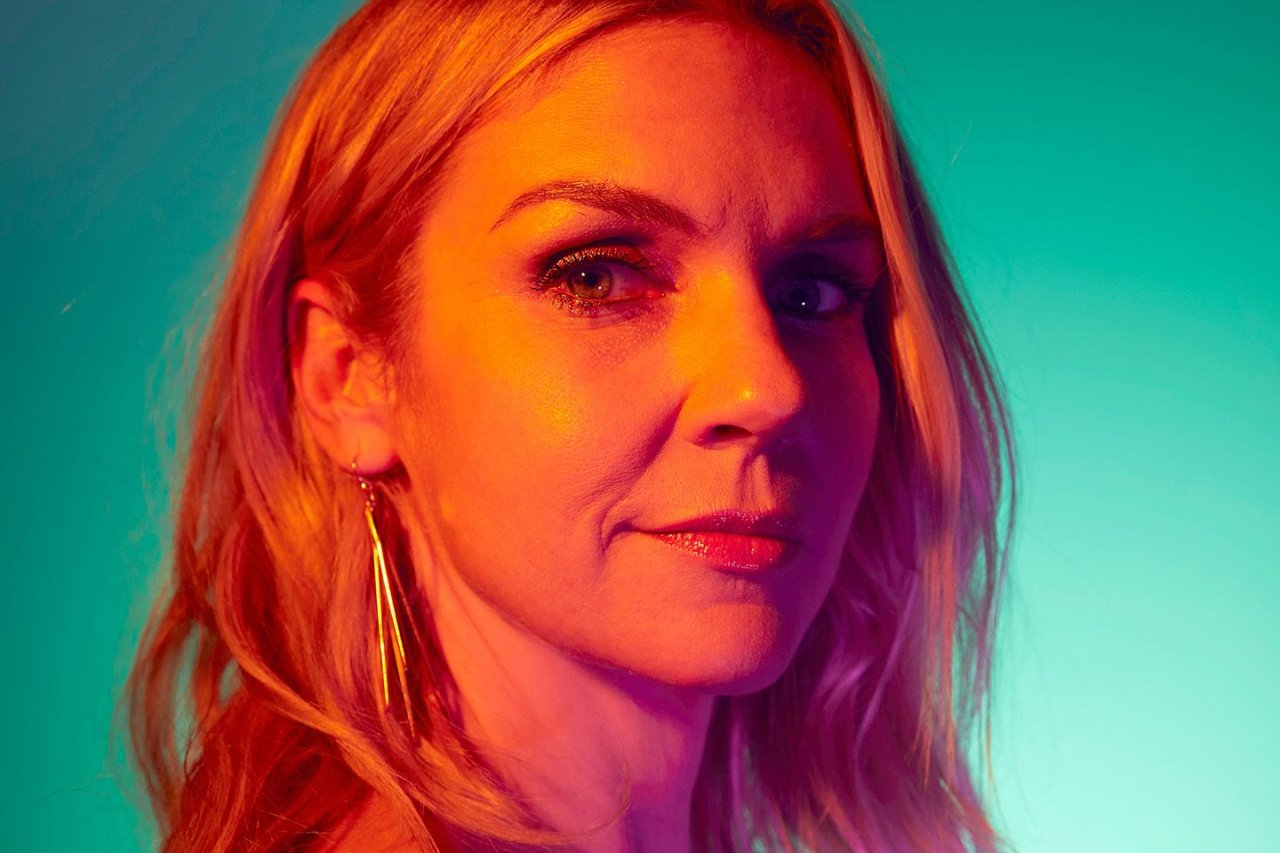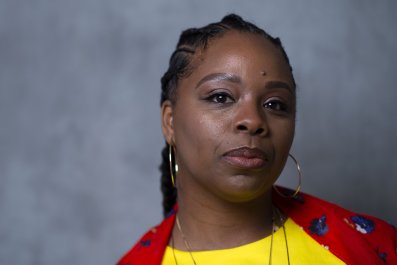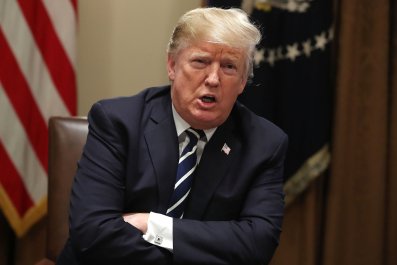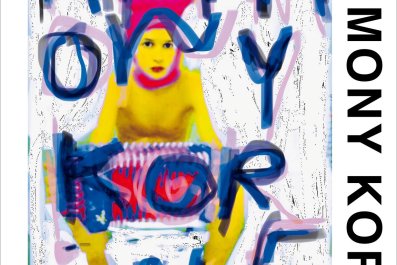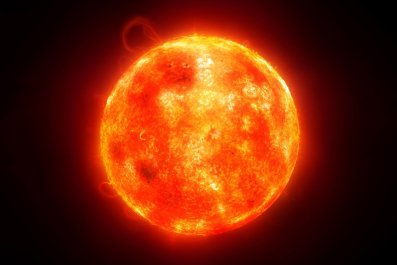Rhea Seehorn has just two lines of dialogue in the pilot of Better Call Saul. In her first scene, she's seated at a conference table at Hamlin, Hamlin & McGill, or HHM, the Albuquerque, New Mexico, law firm where she works. Jimmy McGill, who will become Breaking Bad's slippery lawyer Saul Goodman (played by Bob Odenkirk), has barged into a meeting with his usual comic bravado—arms raised, quoting Ned Beatty in the film Network: "You have meddled with the primal forces of nature, and I won't have it!"
He's there to confront Howard Hamlin about money owed his brother, Chuck, the McGill of HHM. Seehorn's character, observing impassively, registers only because she's the sole female at the table.
The meeting does not go well. Jimmy heads down to the parking garage, where he proceeds to treat a metal garbage can like a soccer ball—a can, you note, already bearing numerous dents (clearly things have not gone well before). Pan to a woman leaning against a garage wall, shot noir style, her face hidden in shadow. Jimmy walks over and stands with his shoulder pressed against hers. It's the woman from the meeting. He reaches over and takes the cigarette from her lips, helps himself to a drag and puts it back. He begins to ask her to intervene. "I just can't, Jimmy," she says, dropping the cigarette to the floor and walking to the elevator, where she rights the garbage can and places the lid back on.
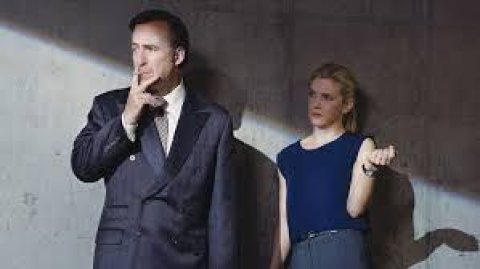
Welcome to Saul's slow-boil magic: With a few deft strokes, the writers of the AMC hit have built enormous intrigue while laying clues for what will become a defining relationship of the series: Jimmy, the irresistible screwup, and Kim Wexler, the cooler head who cleans up his messes.
Saul, as envisioned by producers Vince Gilligan (who created Breaking Bad) and Peter Gould, is built like a puzzle, with pieces meticulously placed for reveals that can take seasons to play out. The experience is not unlike a super-slow-motion train wreck, where the pleasure of watching has more to do with how the inevitable happens than the event itself.
During the first season and into the second, Kim was often described by critics as the show's moral center. It's become apparent, however, that this highly ambitious lawyer—as tightly coiled as her trademark ponytail—is complicated. "Her relationship with Jimmy is sometimes that of accomplices," Gould tells me. "We've found that it's the rule-breaking part of Jimmy—the corner cutting and chaos he creates—that Kim finds very appealing. So calling her the show's moral center is perhaps not accurate," he adds. "The tricky thing about this show is that maybe there's no moral center."
Gilligan and Gould also knew the downside of burdening a character with high-mindedness. Skyler, the fiercely principled wife of Walter White, Breaking Bad's chemistry teacher-turned-meth-manufacturer (played by Bryan Cranston), was roundly disliked for not supporting his criminal activities; the actress who played her, Anna Gunn, endured a backlash that she has described as cruel and bizarre.
"I'm going to be painfully honest," says Gould, who was equally confused by the Skyler resentment. "We didn't want to put that on Kim Wexler." What they have created instead, via Seehorn, is a character that viewers are invested in protecting. As one fan tweeted, "I can deal with all the other characters getting emotionally destroyed, but not her!!!"
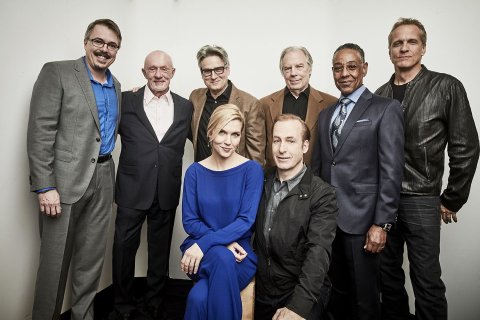
What Gilligan and Gould saw when they watched Seehorn in that first scene three years ago was an ability to pack infinitesimal shadings of nuance into every moment—as well as "the best poker face in the business," says Gould. "We ended up writing to that."
The lighting in the garage was apt. Seehorn as Kim is reminiscent of a defining actress of film noir—Barbara Stanwyck: cool and guarded, wit as dry as the Atacama Desert and sexy because she was smart and self-reliant. Kim's defining line, delivered to Jimmy: "You don't save me. I save me."
"Kim is not looking for someone to complete her, and that's very appealing," says Gould. "But it's also part of the problem in her relationship with Jimmy. He's unhappy and looking for his place in the world. And the way Rhea [pronounced Ray] plays Kim—she has a lot of problems, she's not always getting a fair deal, but she knows who she is."
The show's original problem, says Gould, was, How does Jimmy McGill become Saul Goodman? "That's driven a lot of our thinking," he says."But more and more, we are intrigued by the question of who is Kim Wexler going to become?"
Even after years of interviewing actors, it's disconcerting to be greeted by one who is so not her character. "I'm much more talky-talky than Kim," says Rhea Seehorn, almost in warning, soon after opening the door of her New York hotel room. Her character's armor of off-the-rack pants suits, carefully made-up game face, and perfect ponytail have been replaced by loose hair, bare feet, black-framed glasses and a gregarious openness. You can imagine this woman having the girlfriends Kim notably lacks. "She has some anti-social issues," says Seehorn with a big laugh. "Kim would be a feminist, one of the first people at the parade, so it's not an anti-woman thing. It's an anti-friend thing—she doesn't know how to be friends."
The fourth season, which was shot over five months in Albuquerque, has just wrapped. "It's crazy and dense in every possible way," says Seehorn. "The plot lines, the amount of stories being woven together, the emotional roller coaster that every character is on." Three days after leaving the set, "I'm already itching," she says. "I don't like time off—I would prefer to act maybe 364 days a year." That might explain why she has been engaged to producer Graham Larson for four years. But no: "That we aren't married, yet, has to do with the anxiety planning gives me."
The actress is in New York to appear at the IFC Center's second annual Split Screens Festival, which celebrates the making of TV. This excites the self-described process nerd. It makes sense, then, that her favorite Saul scene is all about procedure—a long montage in Season 2's Episode 5 ("Rebecca"). Kim, armed with a battalion of Post-its and highlighters, works her network of clients to bring new business to HHM—masterful shorthand for the essence of the character. "They don't just say she works her ass off, you have to watch it," she says. "When things get most stressful or emotional, Kim's the one reorganizing her closet."
Seehorn has spent a great deal of time analyzing her character. ("If I had a whole other life," she says, "I'd be a psychiatrist.") With so little to go on, it takes a lot of imagination. Gilligan and Gould leave scant bread crumbs for their actors and viewers. After three seasons, here's what we (and Seehorn) know: Kim moved to Albuquerque from a town on the Kansas-Nebraska border; she met Jimmy in the HHM mail room, rising up through the "cornfield" of doc review; in Season 2 she lands a case, for Mesa Verde Bank, big enough to open a firm, in an office shared with Jimmy.
Kim is smart, pragmatic, hardworking—the kind of woman everywhere in the real world but rare in a medium where aesthetics generally trumps function. "Kim's not frivolous in any way," says Seehorn. "She wouldn't want to be the first thing people notice when she walks into a room." She also flips a lot of TV stereotypes. "Even her obsession with projects—that's the role usually given to men."
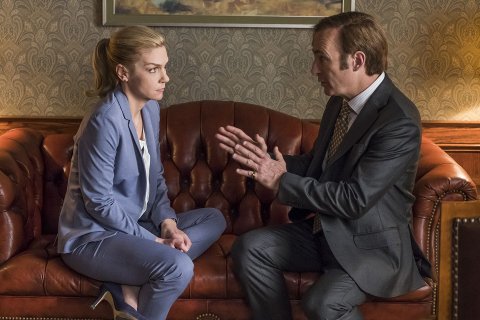
It's her attraction to Slippin' Jimmy that worries fans—the fear that he'll drag her down with him. (Consider that they kiss for the first time after they scam a guy in Season 2.) But Seehorn sees Kim as slippery in her own way: "She's complicated because she does a lot of things on the surface that are about preserving the interior." And Jimmy has his charms: "He's funny," says Seehorn, and also "more loyal than everyone else in her life. He's honest, too—for the most part." She laughs. "He can be the voice of reason sometimes, which is crazy!"
Seehorn dismisses those who suggest she's being played by Jimmy: Kim's too smart. "And weirdly, that makes you assume that he must be intelligent too, or why would he be with someone who gets him? The writers work hard to make sure their characters are not dumb. Jimmy is a very good lawyer.
"It's funny," she adds. "People come up to me and say, 'But Kim would never put up with what Saul did!' And I say, 'Are you talking about what Saul did on Breaking Bad? Kim hasn't seen Breaking Bad!'"
Seehorn graduated from George Mason University in Virginia with a major in art (recent works—a series of small bird paintings—hang over Kim's bed) and a minor in theater. She moved to L.A. in 2003 for a sitcom and ended up working on 14 more. "There are worse things than getting pigeonholed in Hollywood," says the 46-year-old. Still, it can be limiting. "Obviously now there are massive incredible examples, thanks to Vince, of comedy people doing drama." (See Cranston, Odenkirk and Michael McKean, who plays Chuck, Jimmy's brother).
It's a relief, she adds, after her sitcom experiences—where acting often meant "spoon-feeding audiences"—to work on one of the few shows that allow for long-form character development. "There are six- and eight-page dialogue scenes," she enthuses, "where the arc is about the conversation, versus something insane happening."
For an eventful show, Saul is remarkably quiet (one of Season 2's most memorable thrills was the painstaking execution of paperwork forgery). Seehorn savors the long pauses, when "the camera doesn't go anywhere, you just have to sit and feel what the characters are feeling." It's oddly reminiscent of theater, "when you can feel the audience breathing with you. That's the place it gets on Saul, when you shoot those tiny scenes. It's like being on a tightrope with your scene partner and the crew, but also the viewers at home."
As with Breaking Bad, every aspect of the series is intentional, even the color of a shirt, leading to heated online debates about meaning. "They are meticulous with everything, and either that feels freeing or confining," says Seehorn. "If you're on a Peter Gould or Vince Gilligan project, it's because you are able to find the freedom within those parameters." For the actors, that comes on set. "There aren't a lot of directions on the page—you'll never get a note like, 'At this point they start arguing,'" says Seehorn. "That allows us to play around with the director. We shoot many versions of every scene."
Odenkirk and Seehorn have labored to build the patina of a shared past that has never been spelled out. "The writers don't try and explain their chemistry," Odenkirk says. "There's the X factor, which is in any relationship. My wife and I have a certain amount of that. It's a mystery, in a very good way. If you look too closely, you might be able to figure it out, and I don't want to figure it out!"
I'd always imagined Kim's attraction to Jimmy had to do with familiarity; she's had relationships with fuck-ups before, probably members of her family. "I think your imagination is right on!" Odenkirk says. "Not that it gets proven out in the fourth season, but I've heard Peter and Vince talking about Kim's past, and they've alluded to that."
Seehorn agrees. She's come to believe her character is running from something. "I think of Kim as a recovering addict that can't stop hanging out with people that use."

When last we saw Ms. Wexler, in Episode 10 of Season 3, she was recovering from a car accident (after overextending herself for a new client, she fell asleep at the wheel). Emotionally and physically battered, her hair tellingly un-tailed, she has uncharacteristically abandoned work. "I don't think it's giving too much away to say the cast is still on her arm in the first episode," says Gould of the new season. He shares little more beyond the ominous note that "Kim is sorely tested. Rhea has some volcanically emotional scenes, and because she's so restrained, they have enormous impact." ("Episode 3," he adds, "is a barn burner.")
Given Kim's absence from Breaking Bad, Gould hears a lot of theories about Kim, most of them "pretty dire." Seehorn, too, is frequently accosted by fans eager to share ideas about her character's past and future. "That's not accidental," she says. "It's because Vince and Peter insist upon the intelligence of the audience. When they write, they clearly have more than one intention, which allows viewers to come up with all kinds of interpretations." Are the theories plausible? She laughs. "Most of them."
To her mind, killing Kim off seems too obvious. And there are worse fates for her, like "ending up in jail and losing everything if she follows Jimmy down the wrong path."
But what if Kim Wexler did exist on Breaking Bad, in a parallel universe? Saul Goodman, after all, was a peripheral character, rarely seen outside his office. I ask Gould if he's heard the Ice Station Zebra hypothesis. "No!" What's that?" In a Season 2 episode, Kim and Jimmy watch the 1968 Rock Hudson film of the same name, which she says was one of her father's favorites. Later, when they do their first con, the check is made out to Ice Station Zebra Associates. Close watchers of Breaking Bad noted that ISZA (Ice Station Zebra Associates) was the name of Saul Goodman's holding company. Thus the conjecture that Kim was there all along—a behind-the-scenes accomplice, perhaps a partner at one of those white shoe law firms she aspires to. The obsessive who floated this theory also noted that Goodman's desk was Kim's, in the office she shared with Jimmy.
Gould laughs. Saul fans are nothing if not dedicated cryptic-clue detectives. "When we wrote that Breaking Bad episode with the reference to Ice Station Zebra, it just seemed funny," he says. "Now we're learning there's a story behind it."
We're learning? He says this as if he doesn't write the show. "Nothing," Gould adds, "is so wild that it's off the table. If you can picture Kim with Jimmy McGill, can you picture her being with Saul Goodman? What does that look like?" He sounds intrigued.



